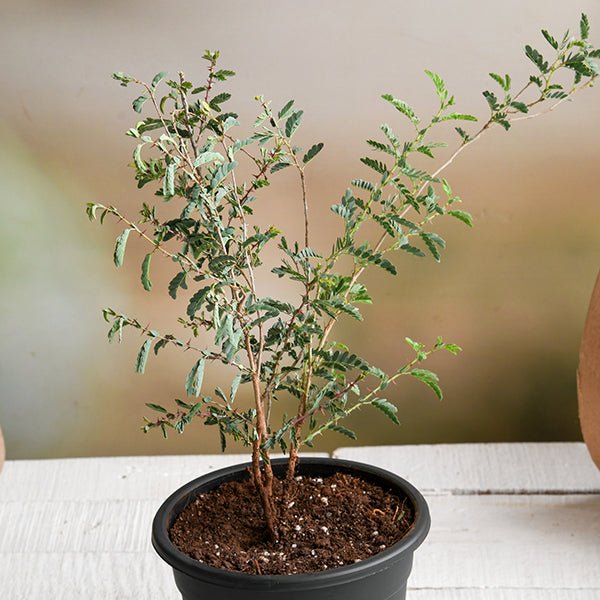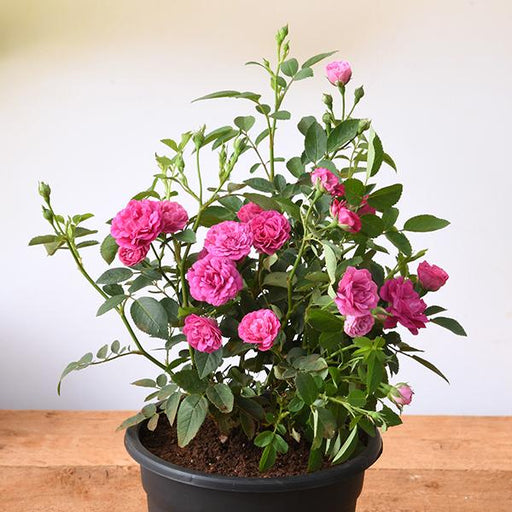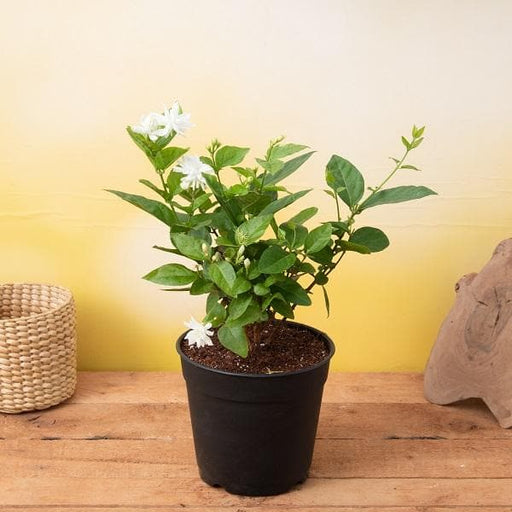
Tree of Rajasthan, Shami - Plant
(MRP Inclusive of all taxes)
- Shipping ₹79 for entire order
- Dispatch in 7 days
- Country of origin: India

(MRP Inclusive of all taxes)
 Save 29%
Save 29%
Air Purifier Money Plant with Pot The Air Purifier Money Plant, also known as Pothos or Epipremnum aureum, is a stunning indoor plant that...
View full details
 Save up to 15%
Save up to 15%
Peace Lily, Spathiphyllum - Plant The Peace Lily, scientifically known as Spathiphyllum, is a stunning houseplant celebrated for its elegant white...
View full details
 Save 25%
Save 25%
Jasminum sambac, Mogra, Arabian Jasmine - Plant Jasminum sambac, commonly known as Mogra or Arabian Jasmine, is a fragrant flowering plant...
View full details
 Save 18%
Save 18%
Combo Constituents Includes the Parijat Tree (Night-Flowering Jasmine), a culturally significant plant with fragrant flowers. Description The Pari...
View full details
 Save 25%
Save 25%
Miniature Rose, Button Rose (Any Color) - Plant The Miniature Rose, also known as the Button Rose, is a charming and compact flowering plant that ...
View full details Save 25%
Save 25%
Damascus Rose, Scented Rose (Any Color) - Plant The Damascus Rose, also known as Rosa damascena, is a timeless symbol of beauty and romanc...
View full details
 Save 17%
Save 17%
Beautiful Fragrant Mogra, Arabian Jasmine Plant with Pot The Beautiful Fragrant Mogra, also known as Arabian Jasmine (Jasminum sambac), is...
View full details Save 15%
Save 15%
Pack of Vermicompost and Neem Cake for House Plants Transform your indoor garden with our premium Pack of Vermicompost and Neem Cake, spec...
View full details
Pack of Plant Growth and Flower Boosters Unlock the full potential of your garden with our Pack of Plant Growth and Flower Boosters! This ...
View full details Save 38%
Save 38%
Combo of Jeevamrut and Neem Raksha for Easy Growth and Protection of Houseplants Transform your indoor garden with our exclusive combo of ...
View full details Save 22%
Save 22%
Plant Nutrients Kit (Pack of 16) for a Healthy Garden Transform your garden into a lush paradise with our Plant Nutrients Kit, featuring 1...
View full details Save 16%
Save 16%
Combo of Top Plant Fertilizers Elevate your gardening game with our exclusive Combo of Top Plant Fertilizers, featuring two bags of premiu...
View full details Save 24%
Save 24%
Pack of 4 Additives to Make Soil Healthy and Nutrient Rich Transform your garden into a thriving ecosystem with our Pack of 4 Additives de...
View full details Save 30%
Save 30%
Transform your gardening experience with our premium Combo of Perlite and Vermiculite. This unique blend is designed to enhance soil aeration and ...
View full details Save 27%
Save 27%
Combo of 2 Vermicompost and Cocopeat - Enrich Your Soil Naturally! Transform your garden into a thriving ecosystem with our Combo of 2 Ver...
View full details
 Save 35%
Save 35%
Best 6 Plants for Perfect Indoor Garden Transform your living space into a lush oasis with our curated collection of the Best 6 Plants for a...
View full details
 Save up to 50%
Save up to 50%
Mini Succulent Garden Pack Transform your space with our Mini Succulent Garden Pack, featuring a delightful collection of 4 any variety beautiful s...
View full details
 Save 30%
Save 30%
5 Best Fragrant Plants Transform your garden or indoor space into a fragrant paradise with our curated selection of the 5 Best Fragrant Plants. Th...
View full details
 Save 24%
Save 24%
Set of 2 Bonsai Looking Grafted Adeniums Transform your indoor or outdoor space with our exquisite Set of 2 Bonsai Looking Grafted Adenium...
View full details Save 45%
Save 45%
Top 4 Die Hard Succulents Pack Transform your indoor or outdoor space with our Top 4 Die Hard Succulents Pack, featuring a curated selecti...
View full details
 Save 30%
Save 30%
5 Best Indoor Plants Pack Transform your living space into a lush oasis with our '5 Best Indoor Plants Pack.' This carefully curated collection fe...
View full details
 Save 25%
Save 25%
Set of 4 Evergreen Air Purifier Plant Pack Transform your indoor space into a lush, green oasis with our Set of 4 Evergreen Air Purifier Pla...
View full details| SrNo | Item Name | Qty |
|---|---|---|
| 1 | Shami Plant | 1 |
The Shami tree, scientifically known as *Prosopis cineraria*, is a remarkable plant native to the arid regions of Rajasthan, India. Revered for its resilience, this drought-resistant tree thrives in harsh climates, making it a symbol of endurance and sustainability. With its beautiful foliage and unique pods, the Shami tree not only enhances the landscape but also plays a crucial role in the local ecosystem.
What makes the Shami tree special is its cultural significance; it is considered sacred in Hinduism and is often associated with the festival of Karva Chauth. Additionally, its ability to fix nitrogen in the soil improves soil fertility, making it an essential component of sustainable agriculture in desert regions.
Special features of the Shami tree include its deep root system, which allows it to access underground water, and its ability to provide shade and shelter for various wildlife. The tree's pods are also a source of food for livestock, making it invaluable to local farmers.
The Shami tree plays a vital role in combating desertification and improving soil health. By fixing nitrogen, it enriches the soil, promoting biodiversity and supporting other plant species. Its deep roots help prevent soil erosion, making it an essential ally in maintaining ecological balance in arid regions.
The Shami tree, also known as Prosopis cineraria, is like the Swiss Army knife of the desert. It offers shade, fodder, and even medicinal properties. Imagine a tree that not only keeps you cool but also serves as a buffet for livestock and a pharmacy for the locals. Talk about multitasking! Plus, its deep roots help combat soil erosion, making it a true hero in the arid landscapes of Rajasthan.
In Rajasthan, the Shami tree is more than just a plant; it’s a cultural icon. It’s revered in folklore and is often associated with the festival of Dussehra, symbolizing victory and resilience. So, when you plant a Shami, you’re not just adding greenery; you’re planting a piece of history and tradition. Who knew trees could be so deep?
Ready to plant your own Shami tree? First, pick a sunny spot because this tree loves to bask in the sun like a beachgoer. Make sure the soil is well-drained; Shami doesn’t like soggy feet. Water it sparingly at first, as it’s a drought-resistant superstar. And remember, patience is key—good things take time, including your future shade provider!
The Shami tree is like a five-star hotel for wildlife. Birds, insects, and small mammals all flock to it for food and shelter. Its pods are a delicacy for many creatures, making it a vital part of the ecosystem. So, when you plant a Shami, you’re not just greening your space; you’re creating a wildlife sanctuary. Who knew being eco-friendly could be so entertaining?
The Shami tree is a superstar in Ayurveda, often used to treat various ailments. Its leaves and pods are believed to have medicinal properties that can help with digestion and even diabetes. So, when you’re feeling under the weather, just remember that your friendly neighborhood Shami tree might have the remedy you need. Nature’s pharmacy is just a tree away!
The Shami tree is a champion of soil conservation. Its extensive root system helps prevent soil erosion, making it a natural protector of the land. In a world where soil degradation is a growing concern, planting a Shami tree is like giving Mother Earth a big hug. So, let’s plant some trees and keep our soil happy!
The Shami tree is the ultimate climate warrior. Adapted to thrive in harsh conditions, it can withstand droughts and high temperatures. By planting a Shami, you’re not just beautifying your surroundings; you’re contributing to climate resilience. It’s like having a superhero in your backyard, ready to fight against the odds!
The wood of the Shami tree is prized for its durability and beauty, making it a favorite among artisans. From furniture to intricate carvings, this tree provides materials for traditional crafts that tell stories of Rajasthan’s rich heritage. So, when you plant a Shami, you’re not just growing a tree; you’re nurturing a future of craftsmanship and creativity.
The Shami tree plays a starring role in various festivals across Rajasthan. During Dussehra, it symbolizes victory and is often worshipped. Imagine a tree that gets more attention than some celebrities! By planting a Shami, you’re not just adding greenery; you’re inviting a piece of festive spirit into your life.
Urban dwellers, rejoice! The Shami tree is perfect for small gardens and balconies. Its compact size and low maintenance make it an ideal choice for city slickers who want to green their space without the fuss. So, whether you have a sprawling garden or a tiny balcony, the Shami tree is ready to make your urban jungle a little greener.
The Shami tree is a natural carbon sink, helping to absorb CO2 from the atmosphere. By planting one, you’re not just beautifying your space; you’re actively participating in the fight against climate change. It’s like giving the planet a breath of fresh air, one tree at a time. So, let’s get planting and make the Earth a little cooler!
The Shami tree, also known as Prosopis cineraria, is Rajasthan's green superhero! This drought-resistant marvel thrives in arid conditions, providing shade, fodder, and even medicinal benefits. It's like the Swiss Army knife of trees, serving multiple purposes while looking fabulous in the desert landscape.
The Shami tree is Rajasthan's pride and joy! It symbolizes resilience and is deeply rooted in local culture and traditions. From being a sacred tree in Hindu mythology to providing sustenance for livestock, it’s the ultimate multitasker, proving that good things come in green packages.
The Shami tree is the ultimate survivor! With its deep roots and small leaves, it minimizes water loss while soaking up the sun. It’s like that friend who thrives at a desert party—always cool, calm, and collected, even when the going gets tough!
Absolutely! The Shami tree can be the star of your garden show. Just ensure you have enough space for its majestic growth. With its stunning foliage and ability to attract wildlife, it’s like having a mini-ecosystem right in your backyard—nature’s very own garden party!
Talk about tree-mendous benefits!
You bet! The Shami tree is an eco-warrior, improving soil quality and preventing erosion. Its ability to thrive in dry conditions means it requires minimal water, making it a sustainable choice for reforestation. Planting a Shami tree is like giving Mother Earth a high-five!
The Shami tree can reach heights of up to 10 meters, making it a towering figure in the desert landscape. It’s like the gentle giant of the plant world, providing shade and shelter while standing tall and proud. Who wouldn’t want a giant friend in their garden
The best time to plant a Shami tree is during the monsoon season when the soil is moist and ready for action. It’s like planting a party invitation for the tree to grow and flourish. So, grab your spade and get ready to welcome this green guest!
Watering a Shami tree is like giving it a spa day—just enough to keep it happy! Initially, water it regularly, but once established, it’s a low-maintenance diva. A little rain now and then is all it needs to thrive in its desert kingdom.
Absolutely! The Shami tree is a wildlife magnet, attracting birds, insects, and other critters. Its flowers and pods provide food, while its shade offers a cozy hangout spot. It’s like hosting a wildlife party in your garden—everyone’s invited!
The Shami tree is not picky about soil; it thrives in sandy, loamy, or even rocky terrains. It’s like that friend who can adapt to any situation—just give it a little love, and it’ll flourish. So, whether your soil is fancy or basic, the Shami tree will feel right at home!
While the Shami tree is pretty resilient, it can occasionally attract pests like leaf-eating caterpillars. But fear not! A little neem oil or natural pest control can keep these uninvited guests at bay. After all, every tree deserves a pest-free zone to shine!